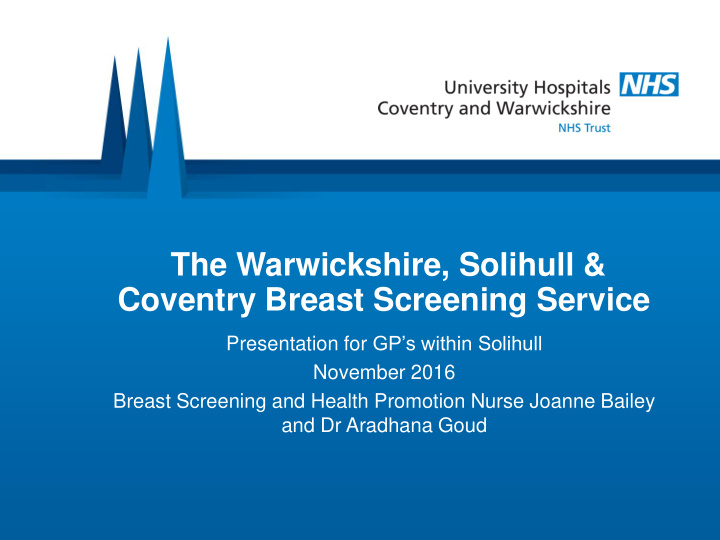



The Warwickshire, Solihull & Coventry Breast Screening Service Presentation for GP’s within Solihull November 2016 Breast Screening and Health Promotion Nurse Joanne Bailey and Dr Aradhana Goud
Why Screen for Breast Cancer? The advantages of screening are: – Reduced mortality – The possibility of more conservative treatment – Small cancers are most likely to be treated with WLE and Radiotherapy
Disadvantages • Uncomfortable • Over diagnosis - DCIS • Radiation - Minimal
WSCBSS Results 2014/15 • Invited 55,752 women (all ages) • Screened 42,051 women – 75% uptake – Recalled 7.65% – Found 374 women with cancer of which 231 were invasive – 11% of patients recalled had breast cancer – Cost £37-50 per woman invited, £45-50 per woman screened
National Results for 2014/15 • 2.80 women invited within age group 45 – 73yrs on the increase! • 2.2 million women screened (71.3%) on the decline! • 19,268 screen detected breast cancers Mortality has now begun to decline. 98% of women with a screen detected breast cancer, are alive at 5yrs.
Breast Screening Programme • Which women should be screened? – 50-70 - routinely invited – 70 and over - on request – Age expansion trial 47-73 – Randomly selected per GP practice by NBSP
Warwickshire, Solihull and Coventry Breast Screening Service • Main site at UHCW • Static Site at George Eliot Hospital • 3 Mobile Units, covering North, South and Central Warwickshire • New Unit within City of Coventry Health Centre
Breast Screening Locations Solihull – Mobile Unit Rear of Solihull Hospital on Union Road Chelmsley Wood – Mobile Unit North Solihull Leisure Centre
The Screening Process • Screen by GP Practice • Once every 3yrs
Uptake – regional 2014/15 Breast Screening Service 2014/15 Key outcome measure MBW MDU MHW MST MSH MBS MAS MCO WM Overall uptake rate 65.0 72.0 74.8 75.5 76.5 70.4 73.5 72.2 72.0 Uptake rate - prevalent screen 61.4 71.1 74.0 70.0 75.2 67.2 69.6 68.2 69.9 Uptake rate - incident screen 84.6 88.9 87.4 89.7 88.2 87.5 88.1 87.5 87.5 Round Length 98.0 94.0 87.0 99.0 96.0 96.0 97.0 97.0 95.5 Screen to result 99.4 98.4 99.6 83.1 99.4 99.1 98.9 96.7 97.3 Screen to Assessment 93.8 90.4 96.7 69.1 90.7 92.3 94.4 88.8 89.3 TCTP 2.2 1.5 2.5 2.0 1.8 2.1 2.8 2.6 2.3 Non-operative diagnosis - invasive 100.0 98.6 99.5 100.0 99.3 100.0 99.4 99.1 0.0 Non-operative diagnosis - non invasive 95.8 77.5 93.0 91.9 88.4 84.2 94.9 89.9 0.0 SDR - all sizes - overall 1.42 1.82 1.51 1.17 1.55 1.33 1.60 1.59 1.51 SDR - all sizes - prevalent screen 1.91 1.36 1.76 1.41 1.39 1.41 1.53 1.31 1.55 1.34 1.90 1.46 1.14 1.58 1.32 1.61 1.64 1.51 SDR - all sizes - incident screen 1.26 1.95 1.33 1.46 1.55 1.01 1.85 1.29 1.45 SDR (<15mm) - overall Non-Invasive cancer rate - prevalent screen 4.55 2.26 3.03 1.33 2.06 1.80 1.69 2.51 2.54 Non-Invasive cancer rate - incident screen 1.81 2.12 1.19 2.29 1.82 1.90 1.39 1.96 1.76 Recall to Assessment - prevalent screen 4.78 10.09 4.54 10.76 5.67 8.19 6.41 7.65 6.48 Recall to Assessment - incident screen 2.03 3.51 1.68 3.51 2.27 2.85 2.74 3.65 2.70 Short-term recall from A ssessment - overall 0.02 0.01 0.01 0.04 0.03 0.01 0.03 0.02 0.02 100 Benign open biopsy - prevalent screen Target >80% 0.91 3.01 1.21 0.00 0.69 1.80 0.34 1.67 1.12 90 80 70 0.21 0.71 0.22 0.24 0.29 0.51 0.06 0.53 0.32 Benign open biopsy - incident screen 60 % Invited Minimum Std >70% 50 40 Data are presented for women aged 50-70 years 30 20 10 0 MBW MDU MHW MST MSH MBS MAS MCO MDD MDW WM First Screen Subsequent Screen MBW City, Sandwell & Walsall MBS South Birmingham Achieved minimum standard and target MDU Dudley & Wolverhampton MAS South Staffordshire Achieved minimum standard but failed target MHW Hereford & Worcester MCO Warwickshire, Solihull & Coventry Failed both minimum standard and target MST North Staffordshire WM West Midlands MSH Shropshire Where no target is set just green and red are used * NB: The minimum standard is 90% for Screen to Assessment and 100% is expected for Screen to DOFOaA
Uptake rate Target: 80% of the eligible invited population Minimum standard: 70% With declining uptake rates…will the service continue? How can we improve the uptake? Why are is the prevalent uptake so low? Lower in deprived and ethnic minority areas
Health Promotion Visiting GP’s who are under the minimum 70% uptake from previous rounds to implement strategies Educating and presenting to low uptake groups Advertising – social media Auditing how we can improve our service, and look at reasons why people DNA. Check the ROUND PLAN
GP visits • 1) Generic Health Promotion text to be sent from GP practice to promote attending breast screening • 2) Alert system for ladies aged 47- 73 on GP’s and PN’s computers. • 3) Pre-letter from GP practice encouraging ladies to attend for previous DNA ladies. • 4) Telephoning 2 nd DNAs from GP reception • 5 )Learning Disability packs to be sent to relevant pts from GP practice • 6) Advertising on GP website with dates and location of mobile unit/ site. • 7) DVD/ audio CD to be played in the reception area. • 8) Ensure correct languages and relevant info is being displayed in reception area. • 9) Breast Screening Business cards to be added to appointment cards.
Contact us on 02476 967200 www.bscreen.org.uk/coventry Breast Screening and Health Promotion Nurse Joanne.bailey@uhcw.nhs.uk Associate Specialist Dr Aradhana Goud NarayanAradhana.Goud@uhcw.nhs.uk
Recommend
More recommend